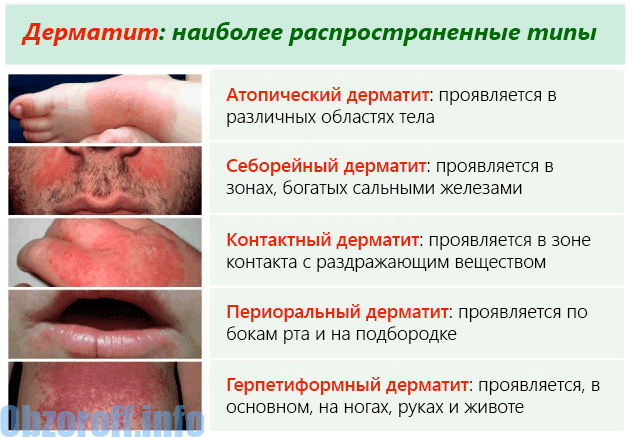Dermatitis is an inflammatory process characterized by pronounced skin diseases. Interaction with the skin of chemical, biological and physical substances leads to an indispensable allergic reaction. It is not an infectious disease, which means it is not dangerous to others.

Skin lesions, dermatitis, due to allergies or inflammation appear due to genetic, acquired or provoked reasons:
- Hereditary predisposition; a consequence of atopic dermatitis; weak immune system; stress; consequences of chronic diseases; exposure to skin temperature, radiation, the sun, food, cosmetics, insect bites.
- Dry dermatitis is a consequence of venous insufficiency, poor blood circulation, insufficient work of sweat glands, swelling of the extremities. When interacting with dry skin, symptoms of redness and cracking appear.
- Itchy, allergic. Diseases of the diabetes mellitus, kidneys, impaired brain function, reaction to allergens cause itching of the skin on the joints, hips, stomach.
- Infectious. Rash caused by diseases of chickenpox, measles, staphylococcus.
- Fungal herpes. Symptoms: a rash against the background of the inflammatory process in the form of a papule, crust. The causes of the appearance may be chronic diseases of the endocrine system, diseases of sweating of the skin.
- Earplug. Symptoms: itching and rash, swelling, damage to the skin of the auricle. The causes of the appearance of ear dermatitis can be called the impact on the skin of chemicals, herpes.
- Red dermatitis is represented by chronic skin diseases. Symptoms: nodular rash, papules, plaques. Skin lesions occur in the area of the mucous membrane of the mouth, and in the joints.
- Food allergens or seborrheic dermatitis. Seborrhea - disruption of the sebaceous glands, characterized by increased or decreased secretion from the sebaceous glands. Promotes the development of asthma. Doctors do not undertake to treat seborrheic dermatitis, as it proceeds in a chronic form. Seborrhea has the following characteristic symptoms: increased diaper rash, scales on the head, reddening of parts of the face. An allergic factor is also isolated as a consequence of the disease in the form of a runny nose, conjunctivitis, increased gas production, and indigestion.
Treatment of dermatitis is possible with the correct diagnosis from a qualified doctor who will select the appropriate antihistamines in accordance with the type of the disease, preventing allergies and reducing its symptoms, and conducting a course of psychological adjustment. Long-term treatment of dermatitis takes at least 28 days.
Rare forms of dermatitis
1. Dühring's dermatitis is characterized by causeless attacks and exacerbations. Symptoms of this unique skin disease are manifested in vesicles, rashes, blisters, which form uncharacteristic for dermatitis forms in the form of rings, long threads. The effect on the skin is manifested in redness, suppuration of the vesicles, the formation of a crust and wounds, and healing. More often the elbow joints, knees, buttocks suffer.
Treatment of skin disease "Dühring" provides drugs such as lipoic acid, "Dapsone", ascorbic acid, vitamin B. You should also follow a special diet. Products containing iodine, cereals, allergens are excluded.
2. Erythroderma is an extensive lesion of the skin. It is difficult to treat. The causes of the disease are allergies and a consequence of existing diseases in humans: fungus, leukemia and others. Symptoms: hair loss, fever, nail damage, heart failure. Treatment of this type of disease is carried out exclusively in special-purpose clinics under the supervision of medical personnel and a highly qualified doctor. The patient needs a specialized ward with a choice of temperature and humidity. Preparations: "Sorbilact", psoriasis cream series "Zdorov", albumin solution, "Reamberin". To strengthen the body, drugs are prescribed to increase immunity and vitamins B, C, E, A. Local application of salicylic ointment.
3. Ritter's leaf-like dermatitis. More often observed in newborns against the background of flowing staphylococcus. It is observed in the genitals, anus, navel. Manifestations in the form of fever and nausea are possible. At the onset of the disease, swelling, redness and blisters form on areas of the skin. The next stage is the appearance of erosion. After that, the dermatitis goes away, the wounds heal. For treatment, externally used erythromycin, colimycin ointments Psorilax, Dermazolone or Lokacorten. In addition to treatment are vitamins of the "C" and "B" groups.
Patients with Ritter dermatitis are observed at the doctor of the infectious disease specialist and dermatologist.
General treatment recommendations
To avoid dermatitis, follow these instructions: use warm water for bathing, use hypoallergenic cosmetics. Include foods rich in vitamin E and A in your diet. To moisturize dry skin, use D-Panthenol and Losterin creams. Wear linen and cotton clothing; avoid stressful situations. Visit specialized medical sanatoriums annually.
And most importantly, never buy drugs on your own if you are not sure of your diagnosis or its side effects. A visit to a doctor will save you from rash purchases and subsequent poisoning of the body.
Our team once became interested in a fashion trend: cryptocurrency trading. Now we manage to do it very easily, so we always get passive profit thanks to insider information about upcoming "cryptocurrency pumps" published in the Telegram channel. Therefore, we invite everyone to read the review of this crypto-currency community "Crypto pump signals for Binance".